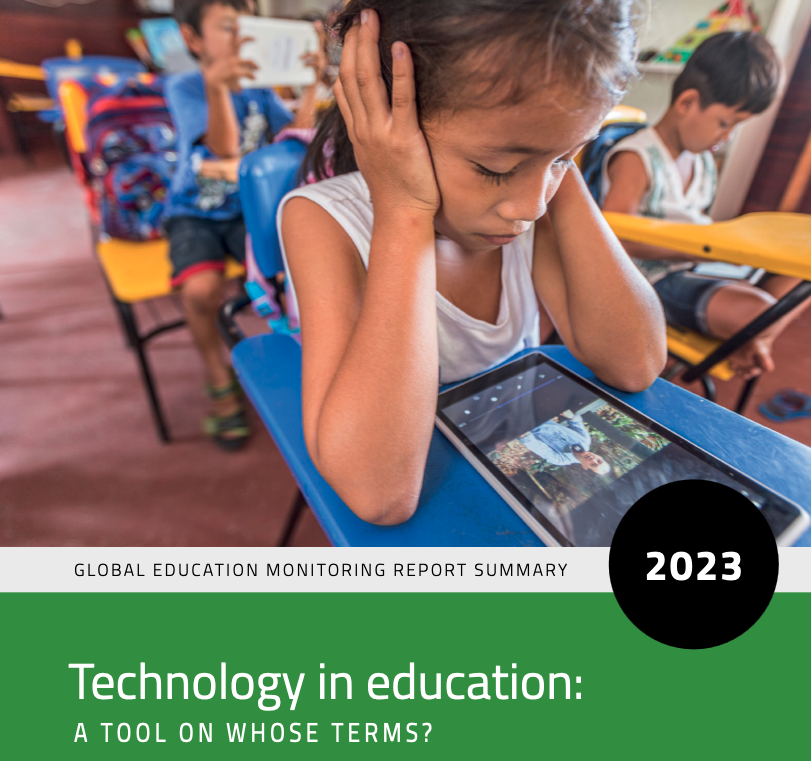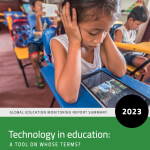Pontydysgu
Seven Approaches to assigning AI
Who promotes education technology as a precondition for education transformation?

UNESCO has published the 2023 edition of the The Global Education Monitoring Report (GEM) entitled "technology in education: a tool on whose terms?" The report is an independent annual publication. The funded by a group of governments,multilateral agencies and private foundations and facilitated and supported by UNESCO. It comes in at a weighty 418 pages with much of interest (I have yo admit I have only read the 32 page summary.
Unusually for a report of this type, it received considerable media attention, at least in the UK. But this was focused on the section of the use of smartphones in school which concluded that "Mere proximity to a mobile device was found to distract students and to have a negative impact on learning in 14 countries, yet less than one in four have banned smartphone use in schools."
The report says that "good, impartial evidence on the impact of education technology is in short supply" adding that here is little robust evidence on digital technology’s added value in education. Technology evolves faster than it is possible to evaluate it: Education technology products change every 36 months, on average. Most evidence comes from the richest countries. In the United Kingdom, 7% of education technology companies had conducted randomized controlled trials, and 12% had used third-party certification. A survey of teachers and administrators in 17 US states showed that only 11% requested peer-reviewed evidence prior to adoption. A lot of the evidence comes from those trying to sell it. Pearson funded its own studies, contesting independent analysis that showed its products had no impact.
The 2018 PISA found that 65% of 15-year-old students in OECD countries were in schools whose
principals agreed that teachers had the technical and pedagogical skills to integrate digital devices in instruction and 54% in schools where an effective online learning support platform was available; these shares are believed to have increased during the COVID-19 pandemic. Despite this the report found that teachers often feel unprepared and lack confidence teaching with technology. Only half of countries have standards for developing teacher ICT skills. While 5% of ransomware attacks target education, few teacher training programmes cover cybersecurity.
The report found that online content has grown without enough regulation of quality control or diversity. Online content is produced by dominant groups, affecting access to it. Nearly 90% of content in higher education repositories with open education resource collections was created in Europe and Northern America; 92% of content in the OER Commons global library is in English. Massive open online courses (MOOCs) mainly benefit educated learners and those from richer countries.
Higher education is adopting digital technology the fastest and being transformed by it the most. There were over 220 million students attending MOOCs in 2021. But digital platforms challenge universities’ role and pose regulatory and ethical challenges, for instance related to exclusive subscription deals and to student and personnel data.
While such technology has tremendous potential, many tools have not been designed for application to education. Not enough attention has been given to how they are applied in education and even less to how they should be applied in different education contexts.
To understand the discourse around education technology, it is necessary to look behind the language being used to promote it, and the interests it serves. Who frames the problems technology should address? What are the consequences of such framing for education? Who promotes education technology as a precondition for education transformation? How credible are such claims? What criteria and standards need to be set to evaluate digital technology's current and potential future contribution to education so as to separate hype from substance? Can evaluation go beyond short-term assessments of impact on learning and capture potential far-reaching consequences of the generalized use of digital technology in education?
Exaggerated claims about technology go hand in hand with exaggerated estimates of its global market size. In 2022, business intelligence providers’ estimates ranged from USD 123 billion to USD 300 billion. These accounts are almost always projected forward, predicting optimistic expansion, yet they fail to give historic trends and verify whether past projections proved true. Such reporting routinely characterizes education technology as essential and technology companies as enablers and disruptors.
If optimistic projections are not fulfilled, responsibility is implicitly placed on governments as a way of maintaining indirect pressure on them to increase procurement. Education is criticized as being slow to change, stuck in the past and a laggard when it comes to innovation. Such coverage plays on users’ fascination with novelty but also their fear of being left behind.
Online Recruitment and the Digital Divide
 There's an interesting article today in WONKHE, the UK online higher education newspaper. Clare Adams in an article entitled "Digital capital is a whole-system issue – building it takes more than hardware", says universities must confront the scale and impact of the digital divide in ways they have not had to do before.
There's an interesting article today in WONKHE, the UK online higher education newspaper. Clare Adams in an article entitled "Digital capital is a whole-system issue – building it takes more than hardware", says universities must confront the scale and impact of the digital divide in ways they have not had to do before.
She proposes building on the six key elements of “digital access” including infrastructure, connectivity, expert instruction and a quiet place to study, as well as the requisite hardware and software, identified by the recent Gravity Assist report on digital learning and teaching.
And although hardware and software are onbioulsy important, she says that research and "reflection on the employer response to the opportunities presented by digital recruitment, finds that technology, which ought to be a huge leveller in terms of creating new pathways into employment and connections with employers for graduating students, is not delivering on its promise."
She says that this "research suggests that inclusion is very much a mindset, not a toolkit. We recommend that students be supported to access the technology they need – and while laptops may be in scarce supply in some households, 98 per cent of people aged 16-24 have access to a mobile device, which indicates the importance of mobile-enabled technologies."
The main proposal is recognising "the importance of developing digital capital – competence and confidence in using, not just recruitment tools, but social networking sites, knowing what to say to make a connection with an employer and online interview and assessment centre hygiene and etiquette – an area where careers services can certainly play a useful role."
"But the capitals lens also suggests measures to boost students’ digital access and competence can only ever chip away at entrenched inequalities.| But with this in mind they they recommend that "employers consider a more proactive approach to recruitment using technology to cast their net connect with possible recruits, and "actively scrutinising whether established recruitment practices are inadvertently excluding potentially great candidates from consideration."
With davancing technology and the Covid 19 pandemic there is a growing trend towards online interviews. But unless active steps are taken this trend might only deepen teh digital divide rather than realising the potential of digital technology to deliver diverse and dynamic graduate recruitment.




